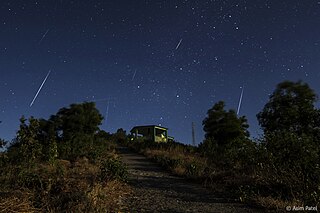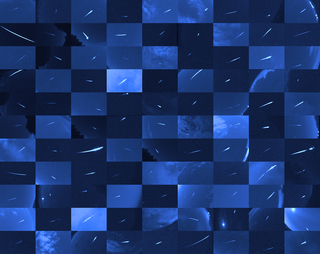Related Research Articles
IMO or Imo may refer to:

The Leonids are a prolific meteor shower associated with the comet Tempel–Tuttle, which are also known for their spectacular meteor storms that occur about every 33 years. The Leonids get their name from the location of their radiant in the constellation Leo: the meteors appear to radiate from that point in the sky. Their proper Greek name should be Leontids, but the word was initially constructed as a Greek/Latin hybrid and it has been used since. The meteor shower peak should be on 17 November, but any outburst is likely to be from the 1733 meteoroid stream.

A meteoroid is a small rocky or metallic body in outer space. Meteoroids are distinguished as objects significantly smaller than asteroids, ranging in size from grains to objects up to a meter wide. Objects smaller than meteoroids are classified as micrometeoroids or space dust. Most are fragments from comets or asteroids, whereas others are collision impact debris ejected from bodies such as the Moon or Mars.

The Geminids are a prolific meteor shower caused by the object 3200 Phaethon, which is thought to be a Palladian asteroid with a "rock comet" orbit. This would make the Geminids, together with the Quadrantids, the only major meteor showers not originating from a comet. The meteors from this shower are slow moving, can be seen in December and usually peak around December 4–16, with the date of highest intensity being the morning of December 14. The shower is thought to be intensifying every year, and recent showers have seen 120–160 meteors per hour under optimal conditions, generally around 02:00 to 03:00 local time. Geminids were first observed in 1862, much more recently than other showers such as the Perseids and Leonids.

A meteor shower is a celestial event in which a number of meteors are observed to radiate, or originate, from one point in the night sky. These meteors are caused by streams of cosmic debris called meteoroids entering Earth's atmosphere at extremely high speeds on parallel trajectories. Most meteors are smaller than a grain of sand, so almost all of them disintegrate and never hit the Earth's surface. Very intense or unusual meteor showers are known as meteor outbursts and meteor storms, which produce at least 1,000 meteors an hour, most notably from the Leonids. The Meteor Data Centre lists over 900 suspected meteor showers of which about 100 are well established. Several organizations point to viewing opportunities on the Internet. NASA maintains a daily map of active meteor showers.

The Perseids are a prolific meteor shower associated with the comet Swift–Tuttle. The meteors are called the Perseids because the point from which they appear to hail lies in the constellation Perseus.
The Quadrantids (QUA) are a meteor shower that peaks in early January and whose radiant lies in the constellation Boötes. The zenithal hourly rate (ZHR) of this shower can be as high as that of two other reliably rich meteor showers, the Perseids in August and the Geminids in December, yet Quadrantid meteors are not seen as often as those of the two other showers because the time frame of the peak is exceedingly narrow, sometimes lasting only hours. Moreover, the meteors are quite faint, with mean apparent magnitudes between 3.0 and 6.0.
WGN may refer to:

The Eta Aquariids are a meteor shower associated with Halley's Comet.
The Beta Taurids (β–Taurids) are an annual meteor shower belonging to a class of "daytime showers" that peak after sunrise. The Beta Taurids are best observed by radar and radio-echo techniques.
The October Draconids, in the past also unofficially known as the Giacobinids, are a meteor shower whose parent body is the periodic comet 21P/Giacobini-Zinner. They are named after the constellation Draco, where they seemingly come from. Almost all meteors which fall towards Earth ablate long before reaching its surface. The Draconids are best viewed after sunset in an area with a clear dark sky.
The Orionids meteor shower, often shortened to the Orionids, is the most prolific meteor shower associated with Halley's Comet. The Orionids are so-called because the point they appear to come from, called the radiant, lies in the constellation Orion, but they can be seen over a large area of the sky. The Orionids are an annual meteor shower which last approximately one week in late October. In some years, meteors may occur at rates of 50–70 per hour.

The Andromedids meteor shower is associated with Biela's Comet, the showers occurring as Earth passes through old streams left by the comet's tail. The comet was observed to have broken up by 1846; further drift of the pieces by 1852 suggested the moment of breakup was in either 1842 or early 1843, when the comet was near Jupiter. The breakup led to particularly spectacular showers in subsequent cycles.

Leonis Minorids [sic] is a weak meteor shower that takes place from October 19 till October 27 each year, peaking on October 23. With a weak moon the meteor shower may be visible with the naked eye, however this meteor shower is best observed only from the Northern Hemisphere with telescopic plotting. This meteor shower is linked to comet C/1739 K1 and radiates from the constellation Leo Minor, which is a faint constellation north of Leo. The meteor shower often only produces 2 meteors an hour. The meteors usually pass at an average speed of 62 kilometers per second.

Comae Berenicids [sic] is a minor meteor shower with a radiant in the constellation Coma Berenices. The shower appears from December 12 to December 23 with the estimated maximum around December 16. The radiant at that time is located at α=175°, δ=+18°. The shower's population index is 3.0 with the speed of 65 kilometres per second (40 mi/s).

The Zeta Perseids (ζ–Perseids) are a daylight meteor shower that takes place from about May 20 to July 5. On the peak date of June 13, the radiant is only 16 degrees from the Sun. The shower was discovered at Jodrell Bank Observatory in 1947 using radio equipment. The Zeta Perseids and Beta Taurids are both probably associated with the Taurid Complex of meteor showers. The Arietids and Zeta Perseids maxima tend to blend into one another.
The Qingyang event was a presumed meteor shower or air burst that took place near Qingyang in March or April 1490. The area was at the time part of Shaanxi, but is now in Gansu province. A 1994 study in the journal Meteoritics tentatively explained this event as a meteor air burst.

On 13 October 1990, meteoroid EN131090, with an estimated mass of 44 kg, entered the Earth's atmosphere above Czechoslovakia and Poland and, after a few seconds, returned to space. Observations of such events are quite rare; this was the second recorded using scientific astronomical instruments and the first recorded from two distant positions, which enabled the calculation of several of its orbital characteristics. The encounter with Earth significantly changed its orbit and, to a smaller extent, some of its physical properties.
References
- ↑ IMO website.
